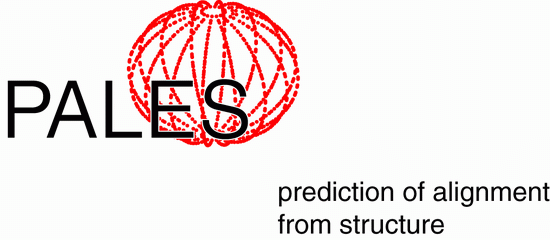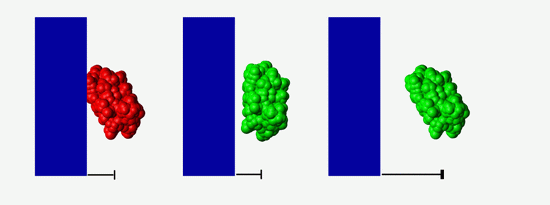

Users are encouraged to email the author to be informed about updates and related software.
PALES is a software for analysis of residual dipolar couplings. Its main component is the PALES (Prediction of ALignmEnt from Structure) simulation that predicts the magnitude and orientation of a sterically induced alignment tensor from a solute's (protein/nucleic acid/oligosaccharide) three-dimensional shape. This can be used to validate the correctness of derived structures, to distinguish monomeric from multimeric structures and to evaluate multiple-conformer models for flexible proteins. In addition, features for analysis of experimental dipolar couplings and dipolar coupling tensors are available, such as best-fitting a dipolar coupling tensor to its corresponding 3D structure.

pales -helpThis gives you the list of available command line arguments.
-stPales
pales -pdb 1IGD_H_sDC.pdb(Default simulation parameters are used and results are written to standard output; the magnitude of alignment scales linearly with concentration and for molecules with dimensions of roughly the rod radius alignment tensors for the wall and the rod model are collinear.)
pales -inD dc_1IGD.tab -pdb 1IGD_H_s.pdb -outD ssiaB.tbl \
-s1 2 -a1 7 -pdbRot rot.pdb
( '-s1' and '-a1' are used for specifying an offset of 5 between the PDB file
and the sequence number of the measured residual dipolar couplings; with
'-pdbRot' a PDB file is written out that is rotated in such a way that the
axes of the alignment tensor are parallel to the laboratory frame.)
pales -inD dc_1IGD.tab -pdb 1IGD_H_s.pdb -outD ssiaC.tbl \
-s1 2 -a1 7 -r1 10 -rN 60 \
-bic -wv 0.03 -dGrid 0.3 -dot 133 -digPsi 23 -rM 33.0 \
-lcS 0.83 -rA 0.3 -H -nosurf
('-r1' and '-rN' are used
for selection of residues 10 to 60 in the simulation.)
-stPalesFree
pales -stPalesFree -pdbF 1IGD_H_s.pdb -outA ssiaF.tbl
pales -stPalesFree -pdbF 1IGD_H_s.pdb -outA ssiaF.tbl \
-bic -wv 0.03 -dGrid 0.3 -dot 133 -digPsi 23 -rM 33.0 \
-lcS 0.83 -rA 0.3 -H -nosurf
-bestFit
pales -bestFit -inD dc_1IGD.tab -pdb 1IGD_H_s.pdb \
-outD svd.tbl -s1 2 -a1 7 -pdbRot rot.pdb \
-map 500 -outMap worldmap.txt
(The '-map' flag is used for mapping the deviation of alignment tensor orientations. These are written to 'worldmap.txt'. 500 iterations are done.)
pales -bestFit -inD dc_1IGD.tab -pdb 1IGD_H_s.pdb \
-outD saupePred.tbl -s1 2 -a1 7 \
-saupe -9.2042e-05 2.3990e-04 3.8255e-04 -4.4549e-04 3.9788e-04
(The order of matrix elements is Szz, Sxx-yy, Sxy, Sxz and Syz.)
pales -bestFit -inD dc_1IGD.tab -pdb 1IGD_H_s.pdb \
-outD dadrFixed.tbl -s1 2 -a1 7 \
-fixed -da -4.135779e-04 -dr -6.901196e-05 \
-psi -43.23 -theta 149.43 -phi 81.40
pales -bestFit -inD dc_1IGD.tab -pdb 1IGD_H_s.pdb \
-outD dadrOnlyFixed.tbl -s1 2 -a1 7 \
-dadr -da -4.135779e-04 -dr -6.901196e-05
-anA
pales -anA -outA anA.tbl \
-inS1 -8.9631e-05 2.4300e-04 3.8479e-04 -4.4164e-04 3.9631e-04 \
-inS2 -1.3042e-05 4.1560e-04 3.5832e-04 -4.6099e-04 4.0923e-04
-anDC
pales -anDC -outD anDC.tbl -inD1 dc_1IGD.tab -inD2 dc_1IGD.tab \
-s1 20 -sN 40
DATA SEQUENCE MQIFVKTLTG KTITLEVEPS DTIENVKAKI QDKEGIPPDQ QRLIFAGKQL
DATA SEQUENCE EDGRTLSDYN IQKESTLHLV LRLRGG
VARS RESID_I RESNAME_I ATOMNAME_I RESID_J RESNAME_J ATOMNAME_J D DD W
FORMAT %5d %6s %6s %5d %6s %6s %9.3f %9.3f %.2f
2 GLN N 2 GLN HN -15.524 1.000 1.00
3 ILE N 3 ILE HN 10.521 1.000 1.00
4 PHE N 4 PHE HN 9.648 1.000 1.00
5 VAL N 5 VAL HN 6.082 1.000 1.00
1 MET C 2 GLN HN 3.993 0.333 3.00
2 GLN C 3 ILE HN -5.646 0.333 3.00
3 ILE C 4 PHE HN 1.041 0.333 3.00
4 PHE C 5 VAL HN 0.835 0.333 3.00
1 MET C 2 GLN N 2.651 0.125 8.00
2 GLN C 3 ILE N -3.768 0.125 8.00
3 ILE C 4 PHE N 1.463 0.125 8.00
4 PHE C 5 VAL N -1.726 0.125 8.00
2 GLN N 2 GLN HN -15.524 1.000 1.00
3 ILE N 3 ILE HN 10.521 1.000 1.00
4 PHE N 4 PHE HN 9.648 1.000 1.00
5 VAL N 5 VAL HN 6.082 1.000 1.00
1 MET HA 1 MET CA -38.341 1.000 0.50
2 GLN HA 2 GLN CA 11.662 1.000 0.50
3 ILE HA 3 ILE CA 18.424 1.000 0.50
4 PHE HA 4 PHE CA 26.733 1.000 0.50
| alpha | Clockwise rotation around z, leading to new system x',y',z' |
| beta | Clockwise rotation around y', leading to new system x'',y'',z'' |
| gamma | Clockwise rotation around z'' |
| 1IGD_H_s.pdb | PDB file of the protein G domain (shortened by 5 residues and protons added with MOLMOL ) |
| dc_1igd.txt | File with measured D(N-HN) dipolar couplings |
| chkPALES2.1.com | Shell script for testing the different modules |
pales -pdb 1IGD_H_sDC.pdb -outD ssia.tbl
REMARK Molecular Alignment Simulation.
REMARK Simulation parameters.
DATA PALES_MODE STERIC
DATA PALES LC_TYPE wall
DATA PALES LC_CONCENTRATION 0.050
DATA PALES ORIENT_SPHERE 100
DATA PALES ORIENT_PSI 18
DATA PALES GRID_SPACING 0.200
DATA PALES MODEL_RADIUS 20.000
DATA PALES LC_ORDER 0.800
DATA PALES ATOM_RADIUS 0.000
DATA PALES SEL_SIMPLE_FLAG 0
DATA PALES SURF_FLAG 1
REMARK Order matrix.
DATA SAUPE -8.9631e-05 2.4300e-04 3.8479e-04 -4.4164e-04 3.9631e-04
DATA IRREDUCIBLE REPRESENTATION (A0,A1R,A1I,A2R,A2I) -3.0583e+00 1.2304e+01 1.1041e+01 3.3849e+00 -1.0720e+01
DATA IRREDUCIBLE GENERAL_MAGNITUDE 2.8438e+01
REMARK Eigensystem & Euler angles for clockwise rotation about z, y', z''.
DATA EIGENVALUES (Axx,Ayy,Azz) 3.0889e-04 5.1593e-04 -8.2482e-04
DATA EIGENVECTORS
DATA EIGENVECTORS XAXIS 1.2036e-01 7.6741e-01 6.2976e-01
DATA EIGENVECTORS YAXIS 8.5264e-01 2.4500e-01 -4.6150e-01
DATA EIGENVECTORS ZAXIS -5.0845e-01 5.9250e-01 -6.2483e-01
DATA Q_EULER_SOLUTIONS ALPHA BETA GAMMA
DATA Q_EULER_ANGLES 1 323.77 128.67 49.37
DATA Q_EULER_ANGLES 2 143.77 128.67 49.37
DATA Q_EULER_ANGLES 3 216.23 51.33 229.37
DATA Q_EULER_ANGLES 4 36.23 51.33 229.37
REMARK Euler angles (psi/theta/phi) for rotation about x, y, z.
DATA EULER_SOLUTIONS 2
DATA EULER_ANGLES -43.48 149.44 81.97
DATA EULER_ANGLES 136.52 30.56 261.97
DATA Da -4.124083e-04
DATA Dr -6.901216e-05
REMARK Dipolar couplings.
DATA N 41
DATA RMS 1.222
DATA Chi2 61.223
DATA CORR R 0.996
DATA CORNILESCU Q 0.120
DATA REGRESSION OFFSET -0.739 +/- 0.148 [Hz]
DATA REGRESSION SLOPE 0.977 +/- 0.015 [Hz]
DATA REGRESSION BAX SLOPE 0.981 +/- 0.010 [Hz]
VARS RESID_I RESNAME_I ATOMNAME_I RESID_J RESNAME_J ATOMNAME_J DI D_OBS D D_DIFF DD W
FORMAT %4d %4s %4s %4d %4s %4s %9.2f %9.3f %9.3f %9.3f %.2f %.2f
2 THR HN 2 THR N -21523.10 1.4640 0.0857 1.3783 1.0000 1.00
3 TYR HN 3 TYR N -21523.10 7.0570 7.8340 -0.7770 1.0000 1.00
4 LYS HN 4 LYS N -21523.10 8.6540 7.3118 1.3422 1.0000 1.00
5 LEU HN 5 LEU N -21523.10 12.1800 10.9437 1.2363 1.0000 1.00
7 LEU HN 7 LEU N -21523.10 12.6910 10.0725 2.6185 1.0000 1.00
8 ASN HN 8 ASN N -21523.10 5.2020 4.5600 0.6420 1.0000 1.00
12 LEU HN 12 LEU N -21523.10 11.6770 10.3776 1.2994 1.0000 1.00
14 GLY HN 14 GLY N -21523.10 10.5530 11.0063 -0.4533 1.0000 1.00
15 GLU HN 15 GLU N -21523.10 11.1540 9.9303 1.2237 1.0000 1.00
16 THR HN 16 THR N -21523.10 11.0090 10.3052 0.7038 1.0000 1.00
17 THR HN 17 THR N -21523.10 8.8740 8.1451 0.7289 1.0000 1.00
18 THR HN 18 THR N -21523.10 5.5190 5.7485 -0.2295 1.0000 1.00
19 GLU HN 19 GLU N -21523.10 5.6510 6.1800 -0.5290 1.0000 1.00
20 ALA HN 20 ALA N -21523.10 4.1730 4.9946 -0.8216 1.0000 1.00
21 VAL HN 21 VAL N -21523.10 4.7990 4.5163 0.2827 1.0000 1.00
22 ASP HN 22 ASP N -21523.10 -4.2940 -4.4661 0.1721 1.0000 1.00
23 ALA HN 23 ALA N -21523.10 -2.3260 -2.5724 0.2464 1.0000 1.00
24 ALA HN 24 ALA N -21523.10 -13.4330 -15.2750 1.8420 1.0000 1.00
25 THR HN 25 THR N -21523.10 -10.5960 -12.4346 1.8386 1.0000 1.00
26 ALA HN 26 ALA N -21523.10 -5.4130 -6.6161 1.2031 1.0000 1.00
28 LYS HN 28 LYS N -21523.10 -16.1580 -16.7218 0.5638 1.0000 1.00
30 PHE HN 30 PHE N -21523.10 -8.6620 -8.3276 -0.3344 1.0000 1.00
31 LYS HN 31 LYS N -21523.10 -13.9680 -14.9181 0.9501 1.0000 1.00
32 GLN HN 32 GLN N -21523.10 -16.0390 -16.6349 0.5959 1.0000 1.00
33 TYR HN 33 TYR N -21523.10 -12.0490 -12.6305 0.5815 1.0000 1.00
34 ALA HN 34 ALA N -21523.10 -9.6080 -10.3609 0.7529 1.0000 1.00
35 ASN HN 35 ASN N -21523.10 -15.6960 -16.4080 0.7120 1.0000 1.00
36 ASP HN 36 ASP N -21523.10 -15.0910 -14.7718 -0.3192 1.0000 1.00
37 ASN HN 37 ASN N -21523.10 -3.6870 -3.9808 0.2938 1.0000 1.00
38 GLY HN 38 GLY N -21523.10 -8.0650 -6.7237 -1.3413 1.0000 1.00
44 THR HN 44 THR N -21523.10 11.6760 9.1670 2.5090 1.0000 1.00
45 TYR HN 45 TYR N -21523.10 11.8120 10.9110 0.9010 1.0000 1.00
46 ASP HN 46 ASP N -21523.10 10.7600 9.6707 1.0893 1.0000 1.00
47 ASP HN 47 ASP N -21523.10 11.0430 10.4336 0.6094 1.0000 1.00
49 THR HN 49 THR N -21523.10 2.4570 0.0918 2.3652 1.0000 1.00
50 LYS HN 50 LYS N -21523.10 8.5140 7.4738 1.0402 1.0000 1.00
51 THR HN 51 THR N -21523.10 9.3680 9.1265 0.2415 1.0000 1.00
52 PHE HN 52 PHE N -21523.10 11.5930 10.7652 0.8278 1.0000 1.00
53 THR HN 53 THR N -21523.10 10.1490 8.8621 1.2869 1.0000 1.00
54 VAL HN 54 VAL N -21523.10 12.2240 9.9134 2.3106 1.0000 1.00
56 GLU HN 56 GLU N -21523.10 11.6220 9.1445 2.4775 1.0000 1.00
Pales is the Roman patron goddess of shepherds and flocks. Pales also presides
over the health and fertility of the domestic animals. Her festival is the Palilia
(also called the Parilia) and was celebrated by shepherds on April 21, the legendary
founding date of Rome. On that day large fires were made through which they
drove the cattle.
Subsequently, an asteroid
(discovered September 19th 1857) and a butterfly ( Boloria
pales ) was named after the goddess.
last updated 2014-11-11